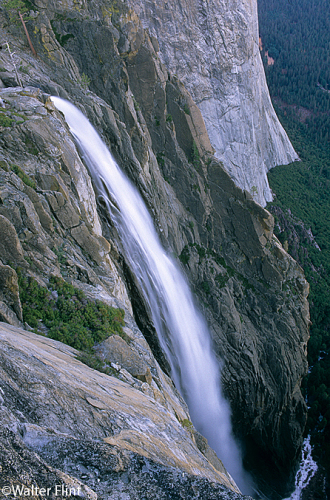Ribbon Fall
click on the image for a larger representation
I have a few photographs that I have taken that I am proud of for the fact that I have never seen another photographer have the same photograph from the same vantage point. The great challenge of being a Yosemite photographer is to present familiar subject matter in new and original ways and not in ways that scream redline on the over-familiarity meter.
Ribbon Fall is an ephemeral, and at 1612 feet in length is the longest single-drop waterfall in North America. Getting to the top of the fall involves a bit of leg work being that it is approximately 10 miles from any chosen trailhead.
During the first few years of the 21st century I would make an annual pilgrimage along the north rim of Yosemite Valley to visit the top of Ribbon Fall, Eagle Peak, and a special spot atop the “Forbidden Wall” overlooking Upper Yosemite Fall. I would time these trips to coincide with the peak runoff of the waterfalls which usually was in late May or early June depending on weather and the previous winters snowpack. This particular vantage point is rarely visited and consequently I would almost never see another person till I got closer to the top of Yosemite Falls; still about four miles away from this location.
My general idea was to make an image of the waterfall that would show it in its entirety in a single, unfettered drop, but this was easier said than done. The spot from which this photo was taken is right at the very edge of a substantial drop-off and subject to some puckering exposure that the uninitiated might find nauseating. This kind of vertical/spacial exposure does not bother me per se as I am a climber and used to great heights and multitudes of exposure. The challenge of this photo was that, as I stood at the very edge of this cliff and looked through the viewfinder trying to navigate my composition, I was not able to get the waterfall in its entirety. I did find that if I leaned way out over the edge of the precipice I could just barely get the photograph that I desired. The key problem was getting the camera on the tripod leaning it out over the edge of the cliff, and then getting my eye to the viewfinder to make the final composition without falling off the cliff.
With my toes at the very edge of the cliff, the camera needed to be about a foot-and-a-half out over the abyss to be able to include the rapids in the bottom right part of the photograph. Once I had determined the basic position and place that camera needed to be, I adjusted the tripod legs to accommodate that position. One of the legs actually had to go out over the edge of the cliff and down about a foot to a small in-cut granite pocket that serendipitously accepted the foot of the tripod securely. Once the tripod and camera in were in their basic positions I then had to lean very carefully and cautiously over the edge of the cliff to compose the image through the viewfinder. I had to constantly remind myself of where I was and how precarious my position was. It is easy to get lost in a composition when one finds their eye and mind glued to the viewfinder of the camera. I did not want to forget where I was and end up doing something really unfortunate like pitching off the cliff and perishing like some poor, dumb, lemming.
I had waited for the sun to set to the West so the image could be completely shot in the subdued light of late afternoon. This time of day set a more quiet and peaceful tone for the image and also allowed me to use a longer shutter speed of about 1 second to turn the waterfall into soft gossamer. The use of a polarizing filter also helped in achieving the longer shutter speed and helped eliminate some surface reflections on the more polished sections of the granite.
Once everything was where I desired it to be I leaned back in from the void, secured the tripod with one hand to keep it from falling, and used my other hand to activate the cable release on the camera body and make the exposure.
The West face of El Capitan stands monumentally in the background and reminds me of my many climbing adventures up its face over the years. Those climbs served me well in dealing with having to lean way out over the edge of the cliff to make this photograph. Don’t believe me?? Go try to get this photograph for yourself and find out!
Nikon F3 HP film camera
Nikon 17-35mm AF-S 2.8 lens at f/16
Fuji Velvia 50 ISO slide film
Nikon circular polarizing filter


